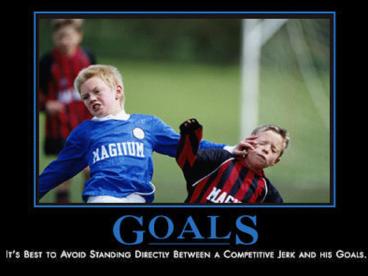Creating SMART goals - PowerPoint PPT Presentation
1 / 18
Title:
Creating SMART goals
Description:
Creating SMART goals S pecific M easurable A ttainable R ealistic T imely (and Tangible) A specific goal has a much greater chance of being accomplished than a ... – PowerPoint PPT presentation
Number of Views:210
Avg rating:3.0/5.0
Title: Creating SMART goals
1
(No Transcript)
2
Creating SMART goals
- S pecific
- M easurable
- A ttainable
- R ealistic
- T imely (and Tangible)
3
Creating specific goals
A specific goal has a much greater chance of
being accomplished than a general goal.
A general goal would be, Implement common core
state standards. But a specific goal would say,
Implement one standard every six weeks, and have
two formative and one summative assessment with
it."
4
Creating specific goals
To set a specific goal you must answer the six
"W" questions Who Who is involved?
What What do I want to accomplish?
Where Identify a location. (Science
Lab)When Establish a time frame. (For
second semester)Which Identify requirements
and constraints. Why Specific reasons,
purpose or benefits of accomplishing
the goal. (To help our students become prepared
for the common core state standards, help them
become college and career ready, and prepare them
for state and national testing.)
5
Creating measurable goals
Establish concrete criteria for measuring
progress toward the attainment of each goal you
set.
When you measure your progress, you stay on
track, reach your target dates, and experience
the exhilaration of achievement that spurs you on
to continued effort required to reach your goal.
6
Creating measurable goals
- To determine if your goal is measurable,
- ask questions such as
- How much?
- How many?
- How will I know when it is accomplished?
7
Creating attainable goals
When you identify goals that are most important
to you, you begin to figure out ways you can make
them come true.
You develop the attitudes, abilities, skills, and
financial capacity to reach them. You begin
seeing previously overlooked opportunities to
bring yourself closer to the achievement of your
goals.
8
Creating attainable goals
You can attain most any goal you set when you
plan your steps wisely and establish a time frame
that allows you to carry out those steps. Goals
that may have seemed far away and out of reach
eventually move closer and become attainable, not
because your goals shrink, but because you grow
and expand to match them.
9
Creating realistic goals
To be realistic, a goal must represent an
objective toward which you are both willing and
able to work.
A high goal is frequently easier to reach than a
low one because a low goal exerts low
motivational force. Some of the hardest jobs you
ever accomplished actually seem easy simply
because they were a labor of love.
10
Creating realistic goals
- To determine if your goal is realistic,
- ask questions such as
- Do I truly believe that it can be accomplished?
- Have I accomplished anything similar in the
past? - Can I identify the conditions that would have to
exist to accomplish this goal?
11
Creating timely goals
A goal should be grounded within a time frame.
With no time frame tied to it, there is no sense
of urgency.
When do you want to accomplish your goal?
Someday won't work. But if you anchor it
within a timeframe (by May 1st), then you have
already set your unconscious mind into motion to
begin working on the goal.
12
T can also stand for Tangible
A goal is tangible when you can experience it
with one of the senses, that is, taste, touch,
smell, sight or hearing. When your goal is
tangible you have a better chance of making it
specific and measurable and thus attainable.
13
Creating SMART goals
- S pecific
- M easurable
- A ttainable
- R ealistic
- T imely (and Tangible)
14
Example
- I will implement standards-based grading into my
3rd hour US History class using classroom
instruction strategies and aligning my
assessments to the standards so that students
understand their learning targets and objectives
therefore achieving higher scores as evidenced by
all students achieving 80 or better on unit
tests by May.
15
Evidence/Resources/Action Steps
- Evidence/Research
- Marzano, Standards Based Grading and Formative
Assessments - OConnor, How to Grade for Learning
- Resources Materials
- Literature and collaboration with teachers using
standards based grading. Creation of standards
based assessments. Creation of self-evaluation
benchmark checklists.
16
Evidence/Resources/Action Steps
- Action Steps
- Base-Line Test
- Daily IQs (formative assessment)
- Research
- Collaborate with other staff using SBG
- Collect and analyze assessment data
- Display daily benchmarks in room (point)
- Student Self Assessment Sheets
17
(No Transcript)
18
Example
- I will create benchmarks and standards for Area
Studies Wisconsin to help it come into compliance
with district initiatives and institute benchmark
grading and feedback for my second semester
classes and compare them to my Area Studies
Wisconsin classes from the first semester to show
progress as evidenced by at least a 3 decrease
in failures from first to second semester after
the implementation of the benchmarks.





















![[PDF] DOWNLOAD It's Okay If You Don't Like Golf It's Kind Of A Smart Peo PowerPoint PPT Presentation](https://s3.amazonaws.com/images.powershow.com/10068911.th0.jpg?_=20240701028)
![[PDF] DOWNLOAD It's Okay If You Don't Like Golf It's Kind Of A Smart Peo PowerPoint PPT Presentation](https://s3.amazonaws.com/images.powershow.com/10067546.th0.jpg?_=202406280110)
![[PDF] DOWNLOAD It's Okay If You Don't Like Golf It's Kind Of A Smart Peo PowerPoint PPT Presentation](https://s3.amazonaws.com/images.powershow.com/10060412.th0.jpg?_=20240621055)
![[PDF] DOWNLOAD It's Okay If You Don't Like Golf It's Kind Of A Smart Peo PowerPoint PPT Presentation](https://s3.amazonaws.com/images.powershow.com/10060686.th0.jpg?_=20240621098)






